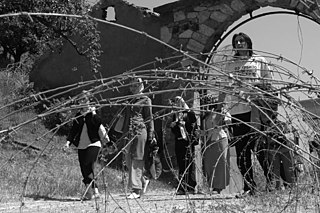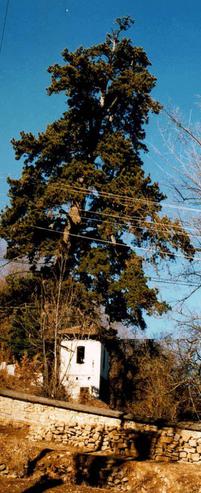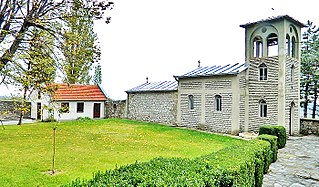
Viti or Vitina is a town and municipality located in the District of Gjilan in Kosovo. According to the 2011 census, the town of Viti has 4,924 inhabitants, while the municipality has 46,987 inhabitants.

The Patriarchate of Peć Monastery or the Patriarchal Monastery of Peć, is a medieval Serbian Orthodox monastery located near the city of Peja, Kosovo. Built in the 13th century, it became the residence of Serbian Archbishops. It was expanded during the 14th century, and in 1346, when the Serbian Patriarchate of Peć was created, the Monastery became the seat of Serbian Patriarchs. The monastery complex consists of several churches, and during medieval and early modern times it was also used as mausoleum of Serbian archbishops and patriarchs. Since 2006, it is part of the "Medieval Monuments in Kosovo", a combined World Heritage Site along with three other monuments of the Serbian Orthodox Church.

Drenica, also known as the Drenica Valley, is a hilly region in central Kosovo, covering roughly around 700 square kilometres (270 sq mi) of Kosovo's total area (6%). It consists of two municipalities, Drenas and Skenderaj, and several villages in Klina, Zubin Potok, Mitrovica and Vushtrri. It is located west of the capital, Pristina.

On 17–18 March 2004, violence erupted in Kosovo, leaving hundreds wounded and at least 19 people dead. The unrest was precipitated by unsubstantiated reports in the Kosovo Albanian media which claimed that three Kosovo Albanian boys had drowned after being chased into the Ibar River by a group of Kosovo Serbs. UN peacekeepers and NATO troops scrambled to contain a gun battle between Serbs and Albanians in the partitioned town of Mitrovica, Kosovo before the violence spread to other parts of Kosovo. Serbs call the event the March Pogrom, while the Albanians call it the March Unrest.

Skenderaj or Srbica is a town and municipality located in the Mitrovica District of Kosovo. According to the 2021 census, the municipality of Skënderaj has 52,586 inhabitants.

The Monastery of the Holy Archangels is a Serbian Orthodox monastery located in Prizren, Kosovo. The monastery was founded by the Serbian Emperor Stefan Dušan between 1343 and 1352 on the site of an earlier church, part of the Višegrad fortress complex. It was the burial church for Emperor Dušan, and represented the culmination of the Serbian ecclesiastical architectural style, that led to the birth of the Morava school style.

The Church of Saint Elijah, also known as Saint Andrew's Church, is а Serbian Orthodox church located on a small hill near the city of Podujevo (Podujevë), in Kosovo. The complex includes an Orthodox cemetery. It was built in 1929, and has been demolished several times, as of 2010, the church has been rebuilt and renovated five times.

Pine of Tsar Dušan was a giant black pine tree located in the courtyard of the old Serbian Orthodox Monastery and Church of the Holy Archangels, in the village cemetery of Gornje Nerodimlje, Ferizaj (Uroševac), Kosovo. The pine tree was planted in 1336 by Stefan Dušan and cut down and burned by local Albanian villagers in 1999.

The Zočište Monastery or formally St. Cosmas and Damian's Monastery is a Serbian Orthodox monastery belonging to the Eparchy of Raška and Prizren, situated in the village of Zočište, about 3 miles (5 km) southeast of Orahovac, Kosovo. The original church, dedicated to St. Nicholas, was built in the 13th century. The graveyard includes tombstones dating back to the 15th and 16th centuries. The monastery was renovated in the 16th century and again in 2008 after being destroyed in 1999. The Church building has been rebuilt on the existing and consolidated foundations using original building material from the ruins of the old church.
Dvoran is a village in the Suhareka municipality in the disputed region of Kosovo. It has 140 inhabitants, all Albanian according to the 2011 census.

Serbian cultural and religious sites in Kosovo were systematically vandalized and destroyed over several historical periods, during the Ottoman rule, World War I, World War II, Yugoslav communist rule, Kosovo War and 2004 unrest.

Church of Holy Trinity was a Serbian Orthodox Church located in the village of Petrič, municipality of Peja, in Kosovo. It was built in 1992 as a donation of the Karić family. The destruction of the church happened shortly after the arrival of the Italian KFOR troops. During the humanitarian tragedy of the Kosovo War, the church was vandalized and completely destroyed in June 1999 by Albanians.

The Gorioč Monastery is a Serbian Orthodox Monastery in Kosovo,being a metohion (dependency) of the Visoki Dečani Monastery. By tradition it was founded in 14. c by Serbian King Stefan Dečanski, as a gift to St. Nicholas for the healing. Gorioč Monastery is situated on Bela Stena, near Istok. Around Monastery church dedicated to St. Nicholas, there are dormitories for nuns and guests as well as bell tower, small economic buildings and fishpond.It depends on the eparchy of Ras-Prizren and appears on the list of cultural monuments of exceptional importance of the Republic of Serbia. The convent complex includes a church, dedicated to Saint Nicholas, a bell tower and the monks' refectory.

The Church of St John the Baptist also known as the Church of St. Lazar in Samodreža, six kilometers east of Vushtrri, Kosovo, is a Serbian Orthodox Church dedicated to the Beheading of St John the Baptist. The church mentioned in the Serbian tradition as the location where the army of Prince Lazar gathered for the Battle of Kosovo (1389). The current building was built in 1932 and was heavily damaged during the Kosovo War and 2004 unrest.
Church of the Holy Apostles was a Serbian Orthodox Church located in the village of Petrovac, Kamenica, Kosovo. It belonged to the Diocese of Raška and Prizren of the Serbian Orthodox Church.

Church of St. Nicholas was a Serbian Orthodox church located in the village of Đurakovac in the municipality of Istok, in Kosovo. It was built on the foundations of an older building from the 14th century, and completely rebuilt in 1592 by the villagers, led by the priest Cvetko. The church belongs to the Eparchy of Raška and Prizren of the Serbian Orthodox Church and is registered as a Cultural Heritage of Serbia.

The architectural heritage of the Kosovo Albanians during Yugoslav rule was shown institutionalised disregard for decades prior to outright conflict at the end of the 20th century. Numerous Albanian cultural sites in Kosovo were destroyed during the period of Yugoslav rule and especially the Kosovo conflict (1998-1999) which constituted a war crime violating the Hague and Geneva Conventions. In all, 225 out of 600 mosques in Kosovo were damaged, vandalised, or destroyed alongside other Islamic architecture during the conflict. Additionally 500 Albanian owned kulla dwellings and three out of four well-preserved Ottoman period urban centres located in Kosovo cities were badly damaged resulting in great loss of traditional architecture. Kosovo's public libraries, of which 65 out of 183 were completely destroyed, amounted to a loss of 900,588 volumes, while Islamic libraries sustained damage or destruction resulting in the loss of rare books, manuscripts and other collections of literature. Archives belonging to the Islamic Community of Kosovo, records spanning 500 years, were also destroyed. During the war, Islamic architectural heritage posed for Yugoslav Serb paramilitary and military forces as Albanian patrimony with destruction of non-Serbian architectural heritage being a methodical and planned component of ethnic cleansing in Kosovo.
The attack on Orahovac was a 3-day long clash Between 17 and 20 July 1998 and was fought between the forces of the Kosovo Liberation Army (KLA) and the FR Yugoslavia. The KLA surrounded Serb villages intending to assert authority for the Kosovo Albanian provisional government through taking over a town and creating a corridor between the KLA hotbed in Drenica and the Albanian border region. 8 KLA fighters and two Yugoslav police officers were killed, as well as five Serb civilians during the attack, while 85 Serb civilians were abducted by the KLA, 40 of whom are presumed to have been murdered. During the takeover of the town by Serbian special police, 79 Albanians civilians were executed.
Joanikije of Devič, archaically also Janićije (Јанићије) was a 15th-century Serbian Orthodox saint.
Monastery of The Saint Archangels Michael and Gabriel, also known as Binač Monastery, or Buzovik (Бузовик), was a Serbian medieval Eastern Orthodox monastery, built in the 14th century. The church had a rectangular foundation, a semi-round apse and a semi-cylindrical vault. There were two layers of frescoes, one on top of the other. The newer layer, from the 16th century, showed archbishops at liturgy.





























